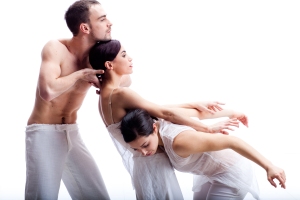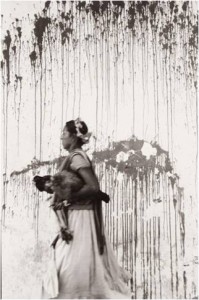Saturday night at the Harris Theater, Luna Negra Dance Theater presented ¡Mujeres!, a one night only show celebrating influential Latina women. Since installing Gustavo Ramírez Sansano as Artistic Director in 2009, Luna Negra has quickly become one of my favorite companies to watch. The new artistic vision and technical ability of the dancers are similar to the style of Hubbard Street Dance Chicago (It was nice to see many HSDC-ers in the audience!) and is a decidedly different direction from the former Luna. For the performance, I think I had the best seat in the house (V 106). It was the “center stage” spot in the audience. I normally sit closer and did miss seeing more of the facial expressions (I didn’t have my glasses), but this seat provided the perfect perch to view the complex patterns and minimal sets. I was excited to see the first piece, Sansano’s world premiere Not Everything, which I’d seen earlier in the month in rehearsals. It not only did not disappoint, but was the best number in the show.
Not Everything was inspired by a photograph by Graciala Iturbide that caught Sansano’s attention at an exhibit in Spain. Opening with a powerful female duet by Renée Adams (in all black) and Mónica Cervantes (in all white), he sets the mood and stage by having Adams intermittently carry a large bucket across and upstage following the path of white linoleum strips laid in an L shape. The weight of the bucket, which we find out at the end of the duet, is loaded with red paint alludes to the heavy internal burden the woman in white (Cervantes) is carrying. Adams pours the paint onto the white strip in a big puddle, unburdening herself before she leaves the stage. The second section, much faster and frenetic, adds in the rest of the company dressed all in black. The dark costumes and dark lighten sometimes made it difficult to see all of the movement. This energetic section personified the flux the woman in white is feeling. The choreography seemed to be controlled chaos with an underlying back and forth swaying that carries over into the final section. That subtle, lulling, repetitive movement assures that the chaos will come to an end. The dancing is so unique and interesting, you barely notice the white panel being slowly lifted to the left, causing the paint to run. The third section is performed in a vertical line moving from stage left to stage right. Cervantes, second from the front, slowly walks undeterred across the front white panel. All the other dancers, in black, dance in front of and behind her pace in a continuous cannon reminding us of the chaos in her mind as she slowly and steadily walks forward. The final image has Cervantes walking in front of the white panel that is now fully vertical with the paint running down recreating the picture that inspired the work. The music, sets and dancing were all beautiful. The final image – stunning. Congrats to Sansano for achieving another remarkable choreographic feat. I, for one, look forward to watching his work for many years.
The second piece, another world premiere, is inspired by the first queen of pre-modern Spain. Asun Noales’ Juana is another dramatic, black and white dance showing the female lead’s decent into insanity. White fabric pieces hanging from the ceiling move up and down ultimately creating the tower in which the queen is locked in by her people. Veronica Guadalupe‘s interpretation of the mad queen was dramatic, strong and heartfelt. Even though she doesn’t leave the stage for the entire piece, it is ther final solo that drives and haunts. The other dancers almost seemed a distraction. The look and feel of the work was too similar to the first piece, that my companions and I questioned whether they should’ve been back to back. The consensus of the group I was with during the second intermission was that the two pieces were so much alike that it almost seemed as if Juana was part two of Not Everything.
The third work was a restaging of work by Michelle Mazanales about the life of Frida Kahlo. Paloma Querida was a big hit with the Luna Negra audience when it premiered in 2010 and the work holds up. Splashes of red and vibrant music lightened the mood created by the first two works, but there was plenty of drama and strong female dancing. Compared to the other pieces that had a more European contemporary feel, Paloma stylistically felt like old Luna. The company is strong and focused and heading in a really interesting, new direction. I’m all for keeping your roots and acknowledging where you came from, but maybe it’s time for Sansano to forge ahead with his own vision. I think the company and the audience is ready.
I want to note a few problems I had with the show. 1. With a one-night-only show, you can’t go back to see it again and this program warrants a second viewing. I want to see it again (especially Sansano’s work). 2. Dedicating the season to women naturally tends to highlight the spectacular women in the company – and that is all of them! – but, the men, who are just as fascinating to watch seemed to be overlooked. Aside from a sassy little solo by Eduardo Zuñiga in the final piece (where he literally almost danced out of his pants), the men didn’t stand out. That’s a shame.



